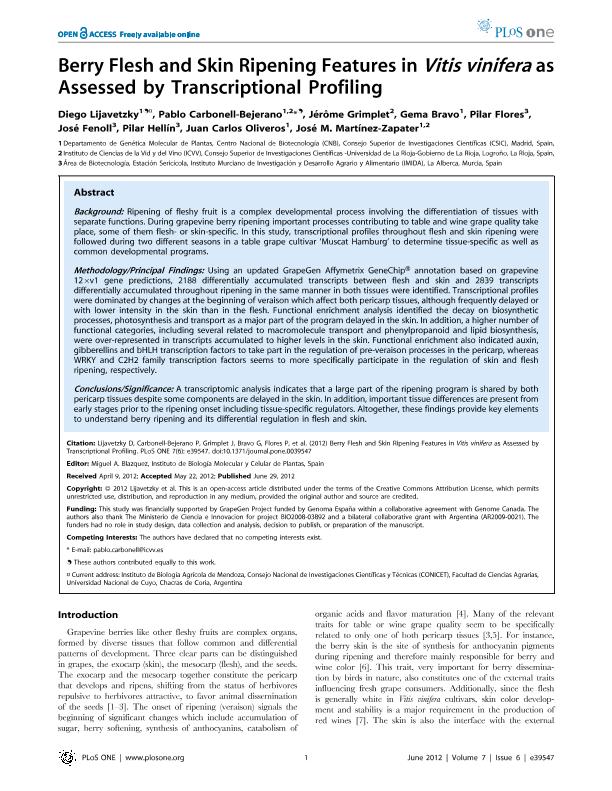Artículo
Berry Flesh and Skin Ripening Features in Vitis vinifera as Assessed by Transcriptional Profiling
Lijavetzky, Diego Claudio ; Carbonell Bejerano, Pablo; Grimplet, Jerome; Bravo, Gema; Flores, Pilar; Fenoll, José; Hellín, Pilar; Oliveros, Juan Carlos; Martinez-Zapater, José M.
; Carbonell Bejerano, Pablo; Grimplet, Jerome; Bravo, Gema; Flores, Pilar; Fenoll, José; Hellín, Pilar; Oliveros, Juan Carlos; Martinez-Zapater, José M.
 ; Carbonell Bejerano, Pablo; Grimplet, Jerome; Bravo, Gema; Flores, Pilar; Fenoll, José; Hellín, Pilar; Oliveros, Juan Carlos; Martinez-Zapater, José M.
; Carbonell Bejerano, Pablo; Grimplet, Jerome; Bravo, Gema; Flores, Pilar; Fenoll, José; Hellín, Pilar; Oliveros, Juan Carlos; Martinez-Zapater, José M.
Fecha de publicación:
05/2012
Editorial:
Public Library of Science
Revista:
Plos One
ISSN:
1932-6203
Idioma:
Inglés
Tipo de recurso:
Artículo publicado
Clasificación temática:
Resumen
Background: Ripening of fleshy fruits is a complex developmental process involving the differentiation of tissues with separate functions. During grapevine berry ripening, important processes contributing to table and wine grape quality take place, some of them flesh- or skin-specific. In this work, transcriptional profiles throughout flesh and skin ripening were followed during two different seasons in a table grape cultivar "Muscat Hamburg" to determine tissue-specific as well as common developmental programs. Methodology/Principal Findings: Using an updated GrapeGen Affymetrix GeneChip annotation based on grapevine 12Xv1 gene predictions, 2188 differentially accumulated transcripts between flesh and skin and 2839 transcripts differentially accumulated throughout ripening in the same manner in both tissues were identified. Transcriptional profiles were dominated by changes at the beginning of véraison which affect both pericarp tissues, although frequently delayed or with lower intensity in the skin than in the flesh. Functional enrichment analysis identified the decay on biosynthetic processes, photosynthesis, and transport as a major part of the program delayed in the skin. In addition, a higher number of functional categories, including several related to macromolecule transport and phenylpropanoid and lipid biosynthesis, were over-represented in transcripts accumulated to higher levels in the skin. Functional enrichment also indicated auxin, gibberellins, and bHLH transcription factors to take part in the regulation of pre-véraison processes in the pericarp whereas WRKY and C2H2 family transcription factors seems to more specifically participate in the regulation of skin and flesh ripening, respectively. Conclusions/Significance: A transcriptomic analysis indicates that a large part of the ripening program is shared by both pericarp tissues despite some components are delayed in the skin. In addition, important tissue differences are present from early stages prior to the ripening onset, including tissue-specific regulators. Altogether, these findings provide key elements to understand berry ripening and its differential regulation in flesh and skin.
Palabras clave:
Vitis Vinifera
,
Microarrays
,
Flesh
,
Skin
Archivos asociados
Licencia
Identificadores
Colecciones
Articulos(IBAM)
Articulos de INST.DE BIOLOGIA AGRICOLA DE MENDOZA
Articulos de INST.DE BIOLOGIA AGRICOLA DE MENDOZA
Citación
Lijavetzky, Diego Claudio; Carbonell Bejerano, Pablo; Grimplet, Jerome; Bravo, Gema; Flores, Pilar; et al.; Berry Flesh and Skin Ripening Features in Vitis vinifera as Assessed by Transcriptional Profiling; Public Library of Science; Plos One; 7; 6; 5-2012; 1-15
Compartir
Altmétricas



